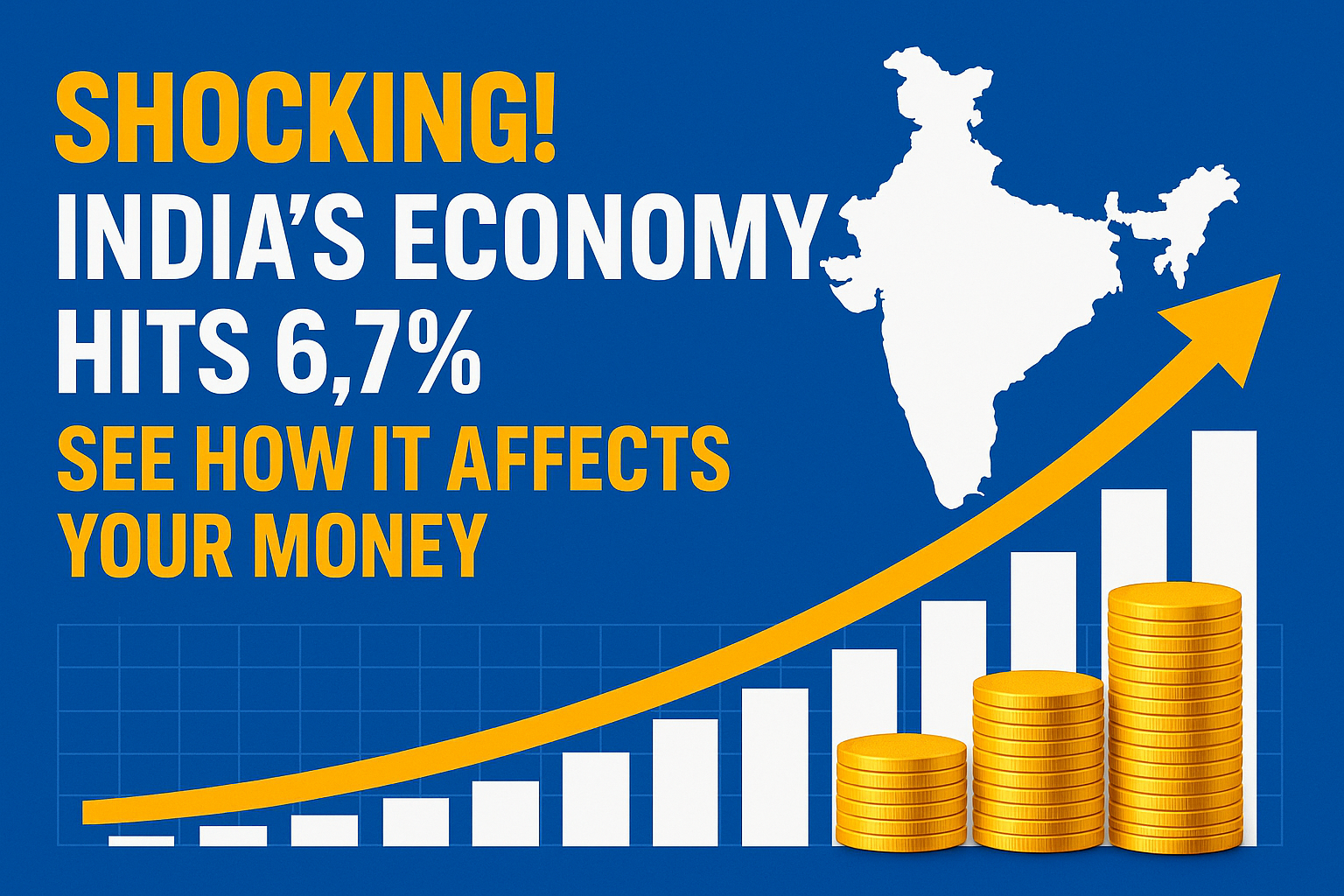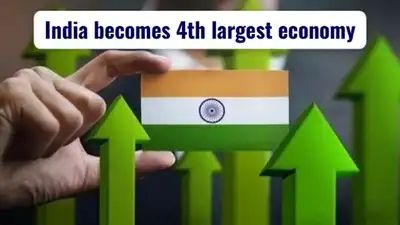
New Delhi, May 25, 2025 — In a significant milestone for the country, India’s economy has officially overtaken Japan to become the world’s 4th largest economy, according to data released by the International Monetary Fund and confirmed by NITI Aayog. The Indian economy expanded at a growth rate of 6.7%, further solidifying its position as one of the fastest-growing major economies globally.
With a nominal GDP of approximately $3.73 trillion, India now ranks behind only the United States, China, and Germany. The development has been widely welcomed by policymakers, economists, and global investors, with many calling it a defining moment in the trajectory of the nation’s economic journey.
India’s economy Has Become 4th Largest Economy: A Historic Shift
According to NITI Aayog CEO B.V.R. Subrahmanyam, this transition reflects the result of over a decade of structural reforms, digitization, and strategic economic policies. “India has become the fourth largest economy in the world, overtaking Japan,” Subrahmanyam confirmed in a press statement.
The IMF’s updated GDP rankings show that Japan’s GDP currently stands at $3.67 trillion, marginally below India’s figure. The development marks a crucial shift in the global economic order and places India firmly on the path toward becoming a $5 trillion economy in the near future.
Breakdown of Key Economic Indicators
| Country | Nominal GDP (2025 Estimate) | Annual Growth Rate |
| United States | $26.9 trillion | 2.2% |
| China | $17.8 trillion | 5.2% |
| Germany | $4.4 trillion | 1.5% |
| India | $3.73 trillion | 6.7% |
| Japan | $3.67 trillion | 0.8% |
India’s GDP growth is being powered by strong domestic consumption, a booming service sector, and the expanding manufacturing base supported by schemes like Make in India and PLI (Production-Linked Incentive).
What Drove India’s Economic Rise?
Reforms and Digital Governance
Experts attribute this economic leap to years of targeted reforms, including the Goods and Services Tax (GST), the Insolvency and Bankruptcy Code, and digital financial infrastructure such as UPI and Aadhaar-linked services. These reforms have increased transparency, boosted tax revenues, and brought millions into the formal economy.
Manufacturing Momentum
India’s shift from a service-dominated model to a more diversified base that includes robust manufacturing has been instrumental. The PLI scheme has incentivized domestic production across sectors like electronics, textiles, and automobiles, attracting both domestic and foreign investments.
Services Sector Strength
Despite the rise of manufacturing, services remain the backbone of India’s GDP. IT and business process outsourcing (BPO) firms continue to deliver significant export revenues, with companies like TCS, Infosys, and HCL expanding their global footprint.
Read Also: UPSC CSE Prelims 2025: Key Highlights

India’s economy isn’t catching up. It’s Overtaking.”
A recent analysis published by Business Today titled “India isn’t catching up. It’s overtaking” challenges the old narrative that India must match other economies in per capita terms to be considered a global player. The report argues that macroeconomic influence is better measured through total output, geopolitical impact, and systemic relevance — all areas where India is gaining ground.
“The country’s large population should be viewed as an asset, not a liability,” said global strategist Saurabh Mukherjea. “India’s expanding middle class and youth-driven workforce make it a global force.”
Sector-Wise Contributions to India’s Economy
India’s economic momentum is being driven by multiple sectors. Here’s how they are performing:
Agriculture
- Continues to support over 40% of the workforce
- Government schemes such as PM-Kisan and irrigation projects have improved resilience
- Faces challenges related to climate change and small landholdings
Manufacturing
- Grown significantly under Make in India and PLI
- Focus on electronics, semiconductors, and defense manufacturing
- Strategic push to replace China in global supply chains
Services
- Largest contributor to GDP at over 50%
- Sectors like IT, fintech, tourism, and logistics are seeing high growth
- Services exports have crossed $300 billion annually
Startups and Innovation
- India now has the third-largest startup ecosystem globally
- Over 100 unicorns across tech, health, edtech, and retail
- Government’s Startup India mission offers incubation, funding, and tax benefits
Read Also: Colonel Sofiya Qureshi’s Family Joins Prime Minister Modi’s Roadshow in Vadodara

The Global Impact of India’s Economic Rise
India’s emergence as the 4th largest economy is set to reshape global trade, investment flows, and diplomatic alignments.
Investor Confidence Grows
According to FDI India, foreign direct investment into India stood at $71 billion in FY24, with major inflows into IT, renewable energy, and infrastructure. “India offers a stable, democratic environment with a skilled workforce,” said Citibank India CEO Ashu Khullar.
A Strategic Global Player
India’s participation in groupings like G20, BRICS, and QUAD enhances its influence on global governance. Prime Minister Narendra Modi has emphasized India’s role as a “Vishwa Mitra” — a global friend and trusted partner.
Students and Youth: What the Growth Means for Them
As reported by Times of India Education, the country’s economic elevation has direct implications for its younger generation. Education institutions are aligning courses with industry requirements, skill development initiatives are expanding, and job prospects in tech and finance are increasing.
Students are advised to focus on:
- Data science and AI
- International business and economics
- Climate tech and sustainability
- Finance and public policy
With India now a top-four economy, international opportunities and collaborations in education and research are expected to multiply.
Addressing the Challenges
Despite its impressive growth, India still faces critical challenges:
Income Inequality
A recent Oxfam report revealed that the top 10% of Indians hold over 77% of the nation’s wealth. Inclusive growth must remain a policy priority.
Per Capita GDP
India’s per capita GDP remains around $2,600 — significantly lower than developed countries. While total output is high, income distribution is uneven.
Employment
The country’s demographic dividend could become a liability if job creation doesn’t keep pace. Economists emphasize the need for skilling programs and labor reforms.
Environmental Sustainability
With rapid urbanization, pollution and ecological degradation have become pressing concerns. India’s commitments under COP28 and green energy initiatives aim to balance development with sustainability.
The Road to a $5 Trillion Economy
Finance Minister Nirmala Sitharaman has reiterated the government’s vision to achieve a $5 trillion economy by 2027. With the current growth rate and policy momentum, the target appears achievable.
Pillars of Future Growth:
- Green hydrogen and renewable energy
- Smart manufacturing and Industry 4.0
- Private sector-led infrastructure projects
- Agricultural modernization through agri-tech
- Deepening financial inclusion and digital banking
Global Reactions to India’s Rise
IMF and World Bank
Both organizations have hailed India as a global economic driver. The IMF called India “a bright spot in a sluggish global landscape,” while the World Bank lauded its digital and financial reforms.
Media Coverage
International outlets such as Bloomberg, The Financial Times, and Reuters have prominently covered India’s ascent. Headlines such as “India’s Growth Defies Global Slowdown” and “The Elephant Overtakes the Sun” reflect the scale of global interest.
A Defining Chapter for India’s Economy
India’s ascent to the 4th position in the global GDP rankings is more than a symbolic achievement. It reflects decades of sustained effort, resilience amid global shocks, and a vision of inclusive growth.
While the road ahead is filled with challenges — from income inequality to employment generation — the foundations for long-term growth are stronger than ever. As India sets its sights on the $5 trillion milestone, the world will continue to watch this economic transformation unfold.







